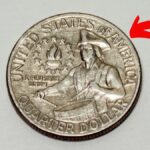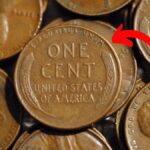The Lincoln Wheat Penny is a rare and highly valued coin that continues to circulate, despite its extraordinary worth. With a current value of $450,000, this coin has caught the attention of collectors and enthusiasts alike. What makes this penny so special, and why is it still in circulation? Let’s dive into the fascinating story behind the Lincoln Wheat Penny, its history, and its continued value in the world of coin collecting.
What is the Lincoln Wheat Penny?
The Lincoln Wheat Penny was first introduced by the United States Mint in 1909 to commemorate the 100th anniversary of Abraham Lincoln’s birth. The coin features a portrait of Lincoln on the obverse (front), designed by Victor David Brenner. On the reverse side, the coin depicts two stalks of wheat, symbolizing the nation’s agricultural heritage. The design of the wheat ears was a symbol of prosperity and the nation’s farming roots, which made the coin even more special to Americans at the time.
The coin’s composition initially consisted of 95% copper and 5% tin and zinc. This mix gave the penny its characteristic reddish-brown color, which became iconic over the years. The Wheat Penny remained in circulation until 1958 when it was replaced by the Lincoln Memorial Penny. However, some rare versions of the coin are still found in circulation today, much to the surprise of many.
Why is the Lincoln Wheat Penny Worth $450,000?
The Lincoln Wheat Penny that is valued at $450,000 is no ordinary coin. It is a 1943 copper penny, a mistake coin that was produced during World War II. During this time, the U.S. Mint was facing a shortage of copper due to the war effort, so they began making pennies out of steel. However, a few copper pennies were mistakenly struck in 1943, and these rare errors have become highly sought after by collectors.
In 1943, most pennies were made from steel, giving them a silvery appearance. But the few copper pennies that were accidentally struck during this time are considered one of the rarest and most valuable coins in U.S. history. Only a handful of these 1943 copper pennies exist today, and their value has skyrocketed over the years due to their rarity and the mistake that led to their creation.
The Rarity of the 1943 Copper Penny
The 1943 copper penny is extremely rare, and only a small number of them have been discovered. Estimates suggest that there are fewer than 20 known to exist, making them a prized possession for collectors. These coins are typically found in private collections or auctions, where they fetch astronomical prices. In fact, in recent years, some of these pennies have been sold for as much as $450,000, depending on their condition and provenance.
The rarity of these pennies is due to the fact that they were never meant to be made. The U.S. Mint had a strict process in place to ensure that steel pennies were produced instead of copper pennies. However, a few copper planchets (the discs used to strike coins) were accidentally mixed in with the steel planchets, leading to the creation of the 1943 copper pennies.
Why is the 1943 Copper Penny Still in Circulation?
Despite its high value, the 1943 copper penny can still be found in circulation, albeit rarely. The main reason for this is that many of the coins were circulated in the past and may still be in circulation today. Since the coin was produced in large numbers (in comparison to the rare error coins), many were used in everyday transactions during the time it was minted.
Over the years, some of these pennies have been passed down, kept in collections, or simply forgotten in jars and coin boxes. As a result, they occasionally resurface in modern-day circulation. However, due to their extreme rarity and high value, they are usually snatched up quickly by collectors or dealers when they are discovered.
For most people, the 1943 copper penny is a curiosity that they may never come across. However, for those who do find one, it’s an exciting opportunity to own a piece of U.S. history worth a significant amount of money.
How to Identify the 1943 Copper Penny
Identifying a 1943 copper penny can be tricky, especially since the vast majority of pennies from that year are made from steel. Here are some key characteristics to look for if you think you’ve found a 1943 copper penny:
- Color: A genuine 1943 copper penny will have a reddish-brown color, unlike the steel pennies from the same year, which have a grayish, silver appearance.
- Weight: Copper pennies weigh about 3.11 grams, while steel pennies weigh only about 2.7 grams. A simple scale can help you determine if the penny is made of copper or steel.
- Mint Mark: The 1943 copper penny was minted in Philadelphia, so it will not have a mint mark (unlike pennies from the Denver or San Francisco mints).
If you believe you’ve found a 1943 copper penny, it’s essential to have it authenticated by a professional coin grading service before attempting to sell or auction it. These services can verify its authenticity and determine its condition, which will directly affect its value.
The Value of Other Lincoln Wheat Pennies
While the 1943 copper penny is the most famous and valuable Lincoln Wheat Penny, other years and versions of the coin are also worth money, especially in higher grades. For example, the 1909-S VDB Lincoln Wheat Penny is another highly sought-after coin due to its limited mintage and historical significance. In general, Lincoln Wheat Pennies from the 1910s, 1920s, and 1930s in mint condition can also be worth more than their face value.
Conclusion
The Lincoln Wheat Penny, particularly the 1943 copper penny, is one of the most iconic and valuable coins in U.S. history. With its extraordinary rarity and rich history, it continues to captivate collectors and coin enthusiasts. While it is still in circulation, finding one of these rare pennies is a once-in-a-lifetime opportunity. If you happen to stumble upon a 1943 copper penny, you may be holding a coin worth hundreds of thousands of dollars, making it a true treasure for any collector.
Disclaimer: The information provided in this article is for general informational purposes only. Coin values can fluctuate, and it is recommended to consult with a professional for accurate assessments and valuations.





